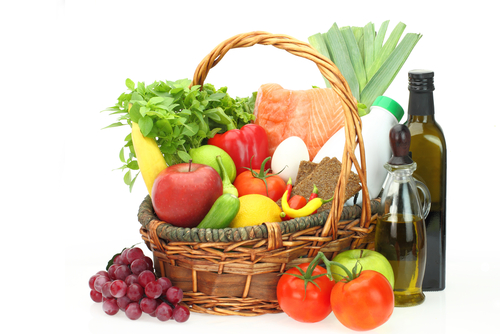Trending Topics
…a hot take on a trending topic
Trending Topics articles are published in timely response to recent media and journal articles, position statements, clinical guidelines, etc. Since they are based on the most recent evidence/publications, they may not be consistent with PEN evidence in other PEN content areas. As soon as possible, when this occurs, the PEN content will be reviewed and updated as needed.
-

Consumer Reports on Infant Formulas: Are They Really Contaminated, and is this Cause for Concern?
Consumer Reports, an American organization, recently published a report on contaminants (such as arsenic and lead) that may be found in infant formulas. The PEN Team asked: what were the findings, and are they relevant to people living outside the USA?

Posted: 2025-11-06
-

Consumer Reports on Protein Powders: Are Lead Levels Cause for Concern?
In October 2025, Consumer Reports, an American organization, published their findings that many protein powders sold in the United States of America (USA) had concerning amounts of lead in them. The safe intake levels defined by Consumer Reports are lower than the safe intake levels determined by Health Canada and the US Food and Drug Administration (FDA). PEN Team asked: what data are these organizations using to determine their safe intake levels, and why do they differ?

Posted: 2025-11-06
-

The NiMe Diet: What is it, and How Might it Affect Dietetic Practice?
A new diet, the NiMe diet, has been designed to restore our industrialized gut microbiomes to their “ancestral” state. The PEN Team asked: what is this diet, and what does it mean for dietitians in practice?

Posted: 2025-09-29
-

Evidence-Based Practice in 2025: Filling the Knowledge-to-Practice Gap
Dietitians know, and care about evidence-based practice (EBP) - but do they apply it regularly in their jobs? Some evidence has suggested that allied health professionals, including dietitians, may begin to feel uncomfortable (or out-of-date) applying their EBP skills within 5 years of entering clinical practice, “particularly for those activities involving critical analysis of published studies”. The PEN Team asked: does this alleged discomfort stop dietitians from applying EBP?

Posted: 2025-09-15
-

Seed Oils: A Case Study In Explaining Pseudoscience to Clients
As dietitians, we tend to have a sixth sense about whether a nutrition claim might be legitimate or not, which can be difficult to explain to clients. A current example would be the fuss surrounding “seed oils” (certain refined vegetable oils, including canola, corn, cottonseed, grapeseed, rice bran, safflower, soy, and sunflower), spurred by the American health secretary’s recent claims that they are harmful and the subsequent media (and social media) attention.
Posted: 2025-08-14
-

Are Iodine Supplements Needed?
Consumer eating habits and resultant diet quality has changed over the years. Individuals are eating away from home more often and are eating more processed and ultra-processed foods which contain lower levels of iodized salt. At the same time, consumers are decreasing their intake of iodized table salt (a major source of iodine) and opting for non-iodized salt options, including kosher, Himalayan pink or sea salt that contain little to no iodine. Concerns have been raised that iodine supplements may be needed to prevent mild to moderate iodine deficiencies that have been increasing.
Posted: 2025-07-02
-

Trending Topic: New Canadian Guidelines: Pediatric Obesity
New Canadian clinical practice guidelines for the management of obesity in children and adolescents were released in April. The Practice-based Evidence in Nutrition: PEN® [PEN] team was asked: do these new guidelines change dietetic practice and how will the PEN database be updated based on the recommendations?
Posted: 2025-05-12
-

Do Emulsifiers Affect the Gut Microbiome?
The PEN team was made aware of recent interest in the role of emulsifiers and gut microbiome and health. Dietary emulsifiers help to combine or stabilize substances that usually don’t stay together when mixed. They affect a food’s appearance, texture and shelf-life and are commonly found in processed and ultra-processed foods such as margarine, mayonnaise and salad dressings, sauces, nut butters, chocolate products, milk and dairy including ice cream products and commercially made baked goods.
Posted: 2025-04-17
-

Does it Matter When You Drink Your Coffee?
It is rare that the PEN Team comes across a nutrition topic that has never been studied before, but that is exactly what happened a few weeks ago. A recent, large study published in the European Heart Journal reported the effect of coffee on heart health. The authors examined whether the timing of coffee intake (just in the morning or throughout the day) influenced people’s risk of dying over a 10-year period.
Posted: 2025-03-04
-

Can Food and/or Supplements be Used To Stimulate GLP-1 Activity to Improve Health Outcomes or Reduce GLP-1 Medication Dose?
Interest in glucagon-like peptide-1 (GLP-1) is transforming the health industry. Many, including health advocates and food and supplement companies, want to promote and develop foods and natural-based products that could increase GLP-1 effectiveness. Dietitians are wondering: do these products really boost GLP-1 activity to improve health outcomes and/or reduce medication dosage for those taking GLP-1 agonists?
Posted: 2025-03-01
-

What Advice can Dietitians Tell their Clients Who Are Concerned About Liquid Smoke?
The Practice-based Evidence in Nutrition: PEN® team was recently asked to consider adding information about liquid smoke into the PEN System as dietitians have been asked questions about it by their clients. An example of a question was, “Are food products with liquid smoke flavour (e.g. smoked almonds, smoked tofu) associated with health risks?”
Posted: 2025-01-27
-

Should Healthy Individuals be Monitoring their Blood Glucose?
Recently, there has been increased marketing for continuous glucose monitoring (CGM) directed towards non-diabetic populations. The PEN® Team looked for available research about the use of CGMs and whether supporting their use in the general population is beneficial.
Posted: 2024-09-03
-

Is Tonic Water a Cure for Foot/Leg Cramps?
Earlier this year, one of the PEN Team members overheard a conversation where an individual was told by a family member to drink tonic water before going to bed to help with foot cramps. The PEN Team thought a review of recently updated PEN content on muscle cramps would help answer this question and assist practitioners.
Posted: 2024-08-07
-

Anti-nutrients: Should They Be Avoided?
Should individuals avoid anti-nutrients, and the plants that bear them? Two dietetic practicum students along with the PEN® Team revisited the topic of anti-nutrients from a previous Trending Topic on Lectins to try to answer this question.
Posted: 2024-07-08
-

What’s the latest on The Dirty Dozen?
The American not-for-profit Environmental Working Group (EWG) has recently published an updated 2024 Dirty Dozen, which lists the fruit and vegetables most contaminated with pesticides. The EWG maintains that children are most likely to be susceptible to pesticide exposure and related health consequences, which has led to the American Academy of Pediatrics listing the Dirty Dozen as a resource for information on pesticide residues in produce.
Posted: 2024-04-22
-

Is Allulose Sweetener Safe to Use in Canada?
Recently, there’s been more attention in the media on the sugar substitute allulose. The PEN Team thought a look into allulose’s characteristics was warranted to help guide practitioners when responding to client questions about this sugar substitute.
Posted: 2024-02-12
-

Energy Drink Consumption in Children and Adolescents: What’s Happening?
A recently published systematic review builds on a previous review examining the evidence of the physical effects of energy drink consumption on children and adolescents.
Posted: 2024-02-12
-

Ultra-processed Foods: Are They Addictive?
Ultra-processed foods: are they addictive? The message is a bit more complicated.
Posted: 2023-11-03
-

Practice Guidelines for Bone Health and Osteoporosis
The Osteoporosis Canada 2023 Guideline Update Group recently completed a review and evaluation of published studies using GRADE to update its 2010 osteoporosis guidelines. The PEN Team reviewed the guidelines against recently updated PEN related content to ensure that dietitians are practicing with the most up-to-date information.
Posted: 2023-10-26
-

Plant-based Beverages – Are They Healthier For Young Children? (Updated)
Plant-based drinks (e.g. rice, coconut, almond, oat, hemp, potato) may not be able to support good health for infants and young children when used as the main beverage.
Posted: 2023-09-27
-

+New Chat: Artificial Intelligence and Dietetic Practice
How accurate is ChatGPT in giving nutrition information and recommendations? Read to the end to fully find out!
Posted: 2023-08-28
-

Can Prescribing Produce Help Manage Type 2 Diabetes?
Can prescribing ‘food as medicine’ have a positive effect on health outcomes, health care costs and health-related quality of life? A recent U.S. study that looked at the impact of implementing a fruit and vegetable prescription program for adults living with diabetes and food insecurity might provide some answers.
Posted: 2023-08-21
-

Mis-Dis Information: Keeping Focused on Evidence-informed Nutrition Practice Recommendations for Autism Spectrum Disorder
The rise in mis- and disinformation throughout and following the COVID-19 global pandemic is well documented. Social media has intensified the rapid spread of misinformation to the public about nutrition and health, which has implications for dietetic professionals.
Posted: 2023-07-20
-

Should My Clients Consume Less Aspartame? The Recent WHO/IARC Report on the Health Impacts of Aspartame
The Joint Expert Committee on Food Additives just released a report assessing the health impacts of aspartame. The PEN Team has been watching the media headlines in anticipation of the report’s release to determine whether a change in practice recommendation was needed on the safety of the daily consumption of aspartame.
Posted: 2023-07-18
-

New Non-Sugar Sweetener Guideline from the World Health Organization
The World Health Organization recently released the Use of Non-Sugar Sweeteners: WHO Guideline. The guideline is based on a 2022 systemic review that used GRADE to summarize the evidence and make a practice recommendation.
Posted: 2023-06-23
-

Does Erythritol Consumption Add to Cardiovascular Risk?
A recent study examined erythritol and the risk of atherothrombotic disease. The PEN Team decided to continue the conversation, exploring whether the study findings suggest taking a closer look at the current practice guidance on sugar alcohols.
Posted: 2023-03-29
-

Added Sugars and Cardiovascular Disease – Is There a New Cause for Concern?
A recent newsletter post from McGill University reviewed a U.K. study that concluded that consuming higher amounts of added sugars increased cardiovascular disease (CVD) risk. This is an important topic with CVDs being the leading cause of death globally. The PEN Team decided to explore if a change in practice guidance is needed based on this study.
Posted: 2023-03-14
-

Anti-inflammatory Diets and Health
Dietitians are receiving client questions about anti-inflammatory diets that have made headlines in recent months and years. Questions focus on including anti-inflammatory foods in everyday dietary patterns to promote overall health and protect against chronic diseases.
Posted: 2023-01-30
-

Low Calorie/Energy Restriction to Promote Type 2 Diabetes Remission - Is There Truth to This?
Recently posted in U.K. university news, the use of low calorie diets by individuals of South Asian ethnicity promoted weight loss, resulting in the remission of type 2 diabetes mellitus (T2DM). Similar postings about T2DM remission have been seen on various social networks, often relating to the DiRECT Trial (Diabetes Remission Clinical Trial), as well as new related clinical practice guidelines in Canada. The PEN Team conducted a quick review of these studies to assess their application to dietetic practice.
Posted: 2023-01-09
-

Does High Protein Dairy Milk Have More Health Benefits than Regular Dairy Milk?
A PEN System user recently reached out to the PEN Team to share their experience with parents of young children choosing high protein milk products for their children and questioned if this is good practice. The PEN Team thought a deeper dive into the possible merits or adverse effects of recommending high protein milk to clients would be useful to dietitians.
Posted: 2022-12-16
-

Dietary Supplements - Can Consumers Trust What’s on the Label and in the Package?
The PEN Team thought a deeper look into mislabelled dietary supplement products might be a topic of interest to practitioners whose clients are, or are considering, taking dietary supplements.
Posted: 2022-11-23
-

#Guttok: Are L-Glutamine Supplements Needed for Gut Health in Healthy Populations?
Social media influencers are sharing their gut health struggles and tips to "hack" your gut” using hashtags such as #guttok, #guthealth and #guthealing. Recently, this included promoting the use of L-glutamine supplements to heal the gastrointestinal system. The content targets individuals experiencing various ailments, including diarrhea, constipation, bloating and other symptoms associated with a ‘leaky gut’.
Posted: 2022-10-23
-

Dietetic Practice and the Effects of Climate Change on the Global Food Supply
Based on a United Nations (UN) report, as the climate changes, food will become more expensive, scarcer and even less nutritious. People across the globe have already started to adapt what food they eat based on what’s available, accessible and acceptable to them.
Posted: 2022-09-15
-

Promoting Cultural Competence Using a Heart Healthy Diet to Lower Cardiovascular Risk Factors
Cultural competence in dietetics is an important aspect of cultivating trust and connection with clients seeking to improve dietary outcomes. Dietary recommendations need to reflect the unique culture of individuals and population(s).
Posted: 2022-08-15
-

North American Shortage of Infant Formula Sparks International Response
There is a shortage of infant formula in the U.S. that has implications for the Canadian market. The shortage of infant formulas for infants with food allergies and certain medical conditions is of particular concern as there are fewer opportunities for formula substitutions.
Posted: 2022-06-15
-

Does a Vegetarian Eating Pattern Affect a Child’s Nutrition Status and Growth?
A 2022 paper, Vegetarian Diet, Growth, and Nutrition in Early Childhood: a Longitudinal Cohort Study, has gained traction on social media. The PEN Team took a closer look at the study to assess if the current PEN recommendations related to children and vegetarian eating are up to date with this latest evidence.
Posted: 2022-05-20
-

Sweeteners and Cancer Risk – Is There a Strong Association?
A recent large cohort study examining artificial sweetener intake with cancer risk concluded that artificial sweeteners were associated with increased cancer risk. This has important implications for practice, given the wide range use of sweeteners in foods and beverages and the frequency that these foods and beverages are consumed.
Posted: 2022-04-13
-

Conflict and the Impact on the Global Food Supply
A key concern for dietitians is the ability of the food system to feed people and then for people to have adequate access to food. This concern is amplified during times of war and conflict, especially for those most directly impacted. There are considerable health and safety implications including access to life-sustaining food and water.
Posted: 2022-03-22
-

Do Veggies Protect Your Heart? Recent Low Quality Evidence Questions Vegetables’ Value
A recent study observed that vegetable consumption was only minimally protective for incident cardiovascular disease. Media headlines subsequently reported that “eating veggies won't protect your heart”. The PEN Team thought an analysis of the study was needed to determine if any changes to current recommendations to “eat lots of vegetables” are required.
Posted: 2022-03-10
-

Food, Nutrition and Wellness Trends 2022
Trends for 2022 show an interest in the consumer, their mental health and wellness, healthy immunity, choices that support a healthy environment, sensible indulgences, reducing alcohol consumption and trying new spices and spicy foods.
Posted: 2022-01-07
-

Vitamin B12 in Pregnancy
A concern about vitamin B12 deficiency causing adverse outcomes in pregnant women, particularly of South Asian descent, prompted us to look more closely at this hot topic. We identified a systematic review (SR) that focused on the vitamin B12 status of women and infants living in India (1).
Posted: 2021-05-25